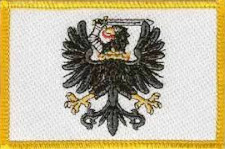-
Who left Germany
Many of our ancestors departed from areas which now belong to Germany. In their day, those places might have been part of Prussia or some other Kingdom left over after the dissolution of the Holy Roman Empire. Those who had migrated naturally enough ended up in the same places as many of the other migrants, oftentimes marrying them. This page covers those related individuals and families who risked life and limb to find a new start in a new world. The migration of these people was the responsibility of an agent who somehow convinced them to leave their homes and go to Australia and most, if not all, of them were brought out by » J. C. Heussler and Co., Agents.
The date in front of the names tells the year of departure.
-
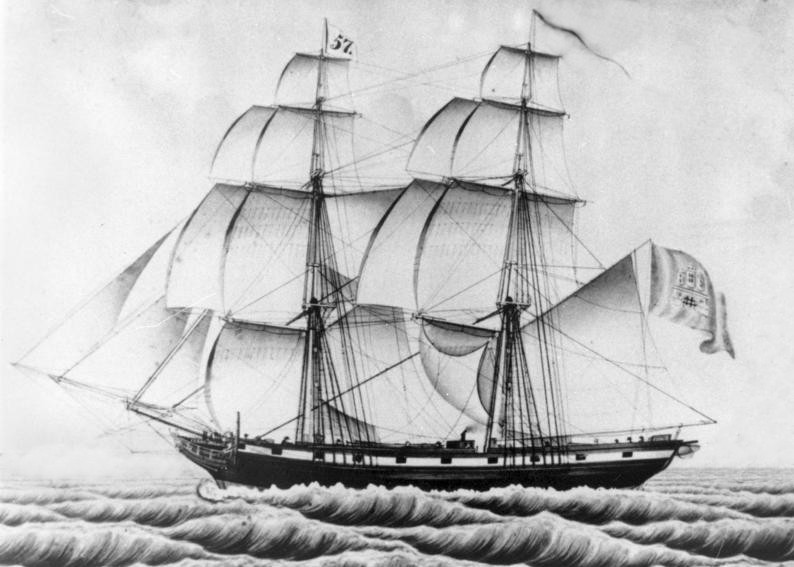
Cesar Godeffroy
dep. Hamburg 25 Oct 1861
arr. Moreton Bay 30 Feb 1862
Captain: Jacob Fürchtenicht
Agent: G. Raff & Co.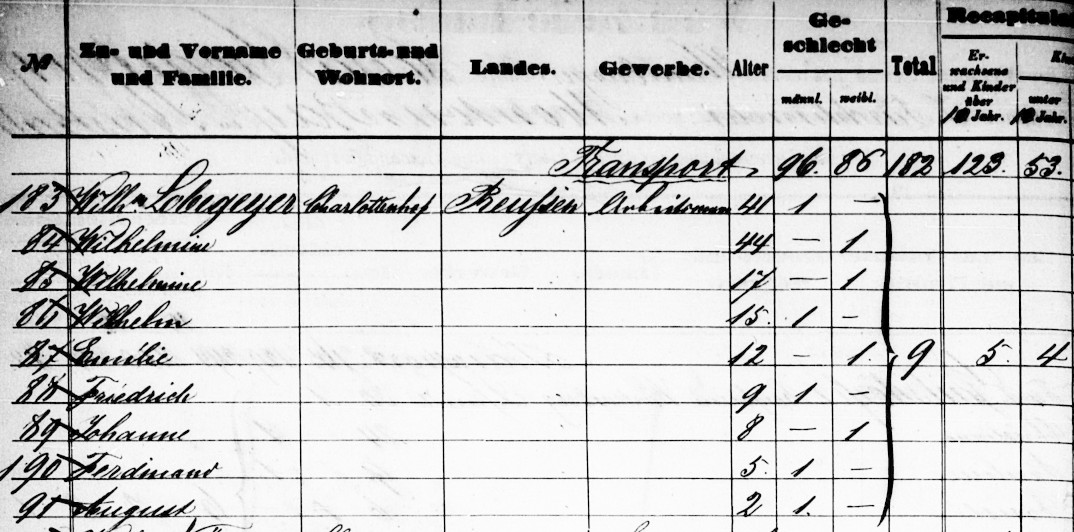
The Lobegeyer family on board the Cesar Godeffroy
1861 August and Caroline Lobegeyer
Friedrich Wilhelm August Lobegeyer, his wife Caroline Wilhelmine Louise Witte and seven of their children left their home in Charlottenhof in the Uckermark near the start of the wave of German migration to Queensland.The large family left Hamburg on board the Cesar Godeffroy under the command of Captain Jacob Fürchtenicht on the 25th October 1861 and arrived in Moreton Bay on February 30th the next year.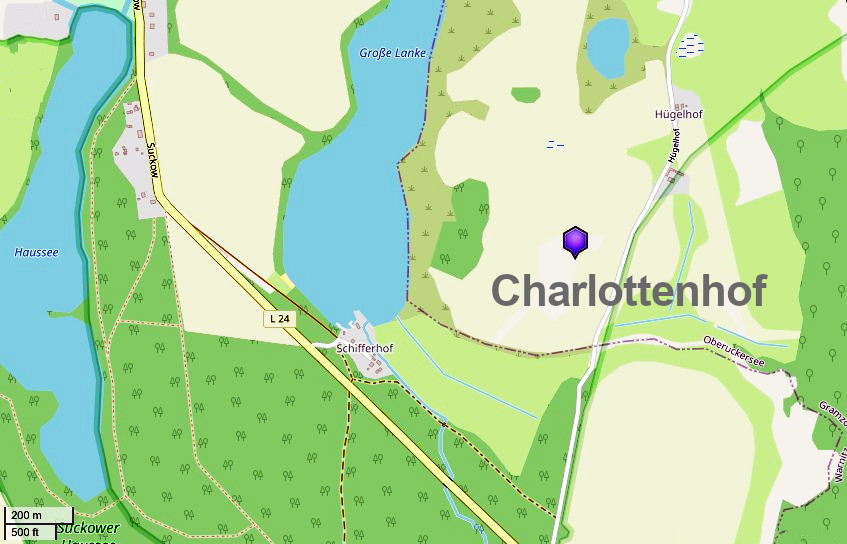
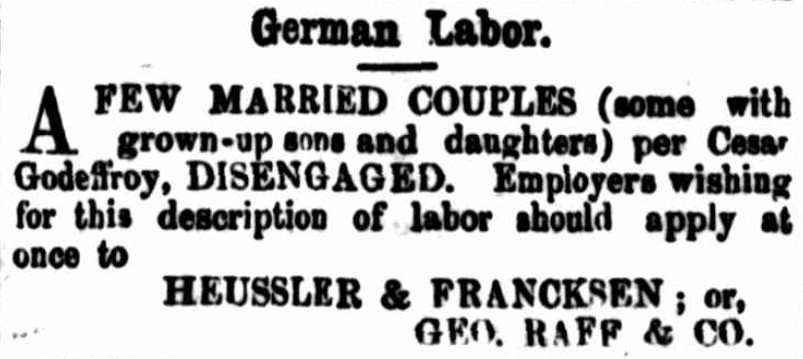
German Labor on offer in the Brisbane Courier 27 Feb 1862
Charlottenhof belonged to the von Arnim family as a » Vorwerk, a type of farm. Although nothing remains of the settlement (known in German as a 'Wüstung'), the location is recorded as being about 2.5 km north of Stegelitz, now called Flieth-Stegelitz, and about 250m from the eastern shore of the 'Grosse Lanke', the lowest arm of the Upper-Ucker-Lake (Oberuckersee).
The children of the Lobegeyer family are many times tied to the Schneiders. For instance, the second eldest son, Frederick, married Ernestine Wolter in Ipswich in 1870 and they had a daughter named Annie who married Johann Heinrich Schneider (the younger), our great-grandfather. The youngest son, August, who was only two years old on the voyage, eventually married Friederike Christine Schneider, who was Johann Heinrich's half sister. The youngest daughter, Johanna Ernestine Caroline Lobegeiger (already with name variation), married Pastor Carl Krüger, who was another good friend of Johann Heinrich Schneider.
-
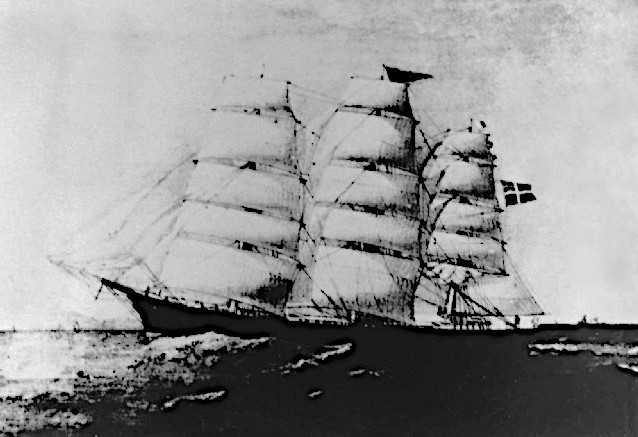
La Rochelle
dep. Hamburg 17 May 1863
arr. Moreton Bay 7 Aug 1863
Captain: J. Junge
Agent: J. C. Heussler & Co.
The Piepers on board the La Rochelle
1863 Johann and Louise Pieper
Johann Friedrich Wilhelm Pieper and his first wife Louise Emily Primus along with three of their children, departed Hamburg on board the La Rochelle on the 17th of May, 1863 and sailed into Moreton Bay on August 7. A few more days were spent on board awaiting the health officer's full approval.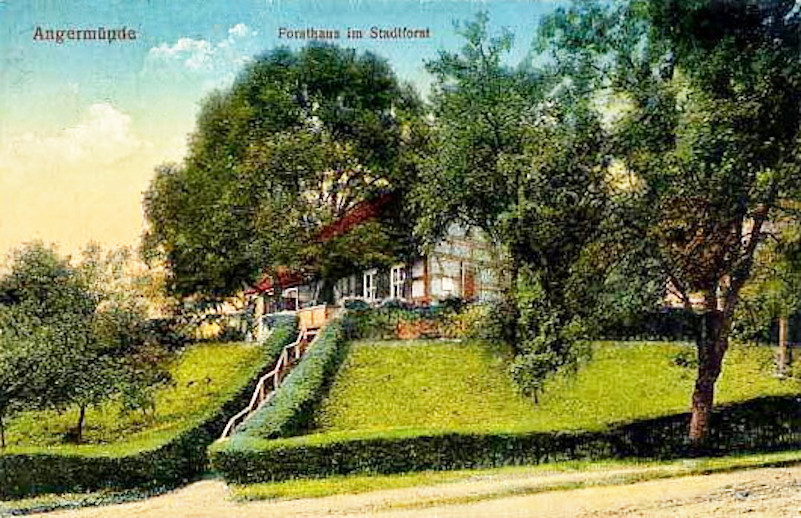
Posttcard Angermünde
Günterberg, Angermünde, Uckermark
The Pieper family came from Günterberg, a part of Angermünde in the Uckermark district of Preussen where they had lived on the land. Hence Johann's position was declared as 'Landmann'. The La Rochelle under the command of Captain Junge, carried the 444 German immigrants safely to their destination in a very excellent run of just 81 days. There was also one passenger in the saloon who was Mrs. Amalie Dietrich, the famed naturalist working for the Godeffroy Museum in Hamburg. This was just one of her many trips to Australia for research and collecting specimens. All the passengers upon arrival were inspected by Dr. Hobbs, the health officer who found them all in a perfectly healthy state.
-
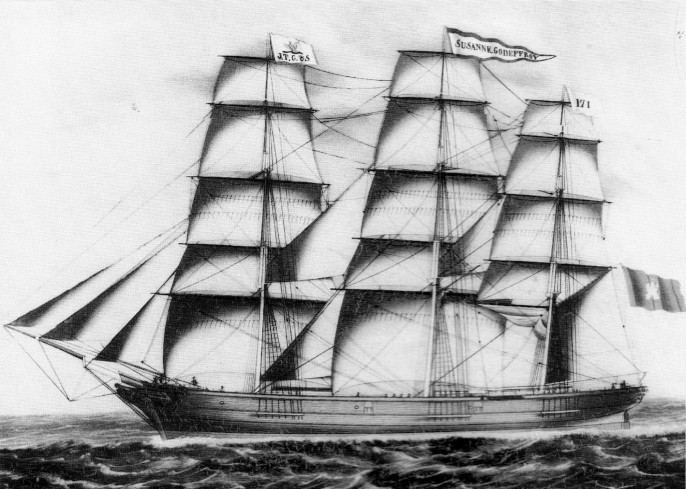
Susanne Godeffroy
dep. Hamburg 19 Sep 1863
arr. Moreton Bay 18 Jan 1864
Captain: H. Müller
Agent: J. C. Heussler & Co.
Michael, Magdalena and family on board the Susanne Godeffroy
1863 Michael and Magdalena Pfeffer
Joseph Michael Pfeffer and his wife Magdalena Elisabetha Krämer, along with six of their children left their home in Neckarsulm to board the Susanne Godeffroy, leaving Hamburg on the 19th of September, 1863 and reaching Moreton Bay on the 18th of January, the next year. One of their sons, Peter Joseph Pfeffer who was already 31 and married, when the rest of his family left, stayed behind. Sadly he died in Neckarsulm only five years later.
Another son, Victor Francis Pfeffer was a very close friend to our 2x great-grandfather, Johann Heinrich Schneider. Victor married Friederike Schulz, the sister of our great-grandmother Ernestine Schulz whose granddaughter, Adelaide Pieper, married Victor Pfeffer's son William. There are lots of other inter-marryings too.
In 1864, the Susanne Godeffroy was reported to be a new ship classed as A1, weighing 914 tons of British measurement. The ship was built in Lübeck for Godeffroy & Co. and this was its first voyage. The time from Lizard Point to first sighting was reckoned to be a run of 98 days.The trip was a rough one, starting immediately with severe weather which detained the ship 15 days in the North Sea. That was followed by contrary winds between the British Coast and Madeira. The trade winds carried her to the Cape of Good Hope but from there to the island of Tristan d'Acunha again there was heavy weather which sprung the main mast, foremast, foretopmast and fore yard. Nonetheless, from there, Tasmania was made in 30 days and Cape Moreton in another ten. Dr. Hobbs, the health officer, visited the ship on the evening of Tuesday the 19th and found the 369 German immigrants, many of whom were skilled workmen, in good health.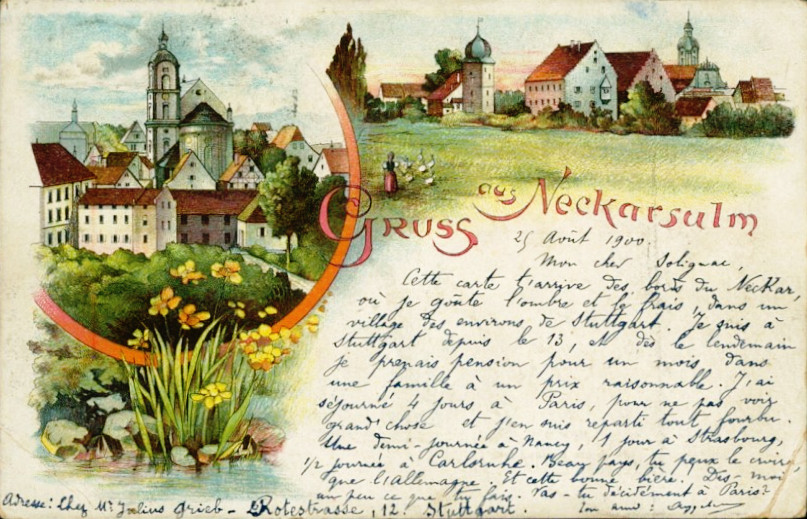
An old postcard announcing Greetings from Neckarsulm
Their cargo included: 1 case pianos, 2 cases cigars, 2 casks hams, 138 cases, 30 half-barrels, 15 quarter-barrels herrings, 10 cases wine, 10 cases seltzer water, 27 cases liquors, 816 packages, 2 packages victuals, 1 parcel publications for Prussian Consulate and 40,600 fire bricks. All in all there were 550 German immigrants on board.
Incidentally, also on board this ship was the Lobegeiger family, namely Wilhelmine Lobegeiger, nee Topp who, after the early death of her husband, eventually married our 2x great-grandfather, Johann Heinrich Schneider, mentioned earlier.
-

Susanne Godeffroy
dep. Hamburg 19 Sep 1863
arr. Moreton Bay 18 Jan 1864
Captain: H. Müller
Agent: J. C. Heussler & Co.
The Lobegeigers on board the Susanne Godeffroy
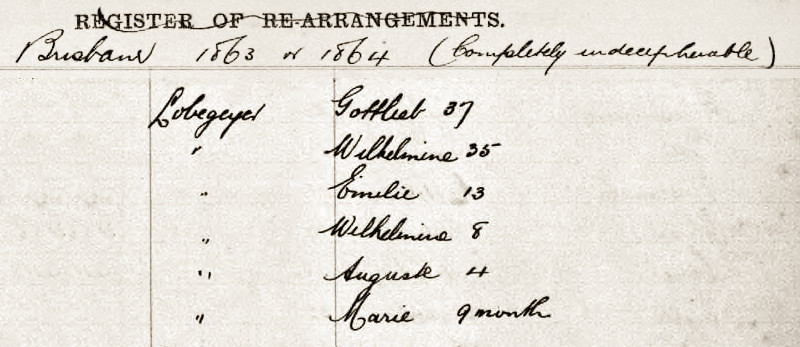
The arrival of the Lobegeiger family in Brisbane
1863 Wilhelmine (Topp) Lobegeiger
One of the Lobegeiger branches of our family stems from Stegelitz in the district of Templin in the Uckermark of Brandenburg, Preussen. Stegelitz is a medieval village first mentioned in 1269 but decimated by the Thirty Year War and newly resettled in the early eighteenth century. Whatever the reason, in 1864, Gottlieb Lobegeiger and his family migrated from Stegelitz to Australia.
Stegelitz on the map
The trip was a rough one, starting immediately with severe weather which detained the ship 15 days in the North Sea. That was followed by contrary winds between the British Coast and Madeira. The trade winds carried her to the Cape of Good Hope but from there to the island of Tristan d'Acunha again there was heavy weather which sprung the main mast, foremast, foretopmast and fore yard. Nonetheless, from there, Tasmania was made in 30 days and Cape Moreton in another ten. Dr. Hobbs, the health officer, visited the ship on the evening of Tuesday the 19th and found the 369 German immigrants, many of whom were skilled workmen, in good health. This was the first journey for the newly built Susanne Godeffroy and the ship made the run in 98 days.
Tragically Gottlieb died three years after arriving. His wife, Wilhelmine (nee Topp) remarried two years later. Her new husband was our g-g-grandfather Johann Heinrich Schneider, Henry senior.
-

La Rochelle
dep. Hamburg 1 June 1864
arr. Moreton Bay 3 Sep 1864
Captain: J. Junge
Agent: J. C. Heussler & Co.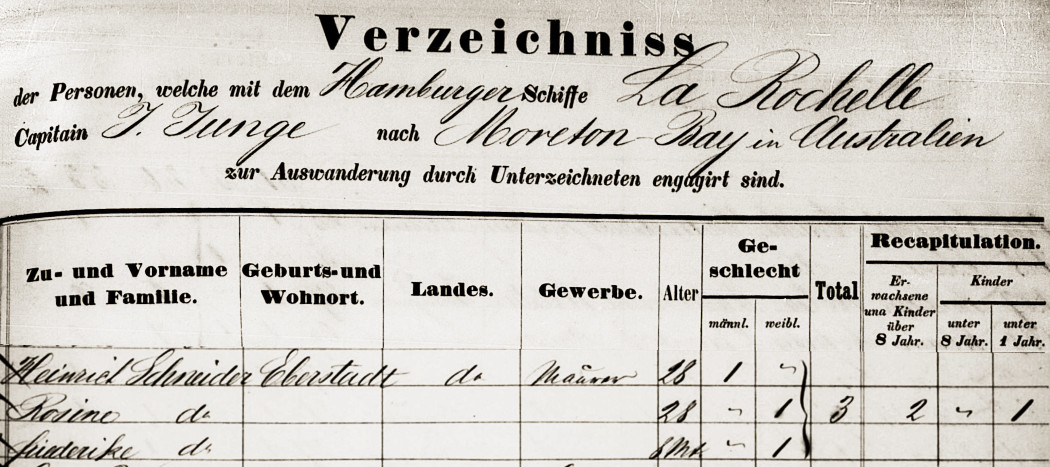
Heinrich, Rosina and daughter on board the La Rochelle
1864 Heinrich and Rosina Schneider
Johann Heinrich Schneider, known as Heinrich and later as Henry, was a master stone mason from Eberstadt in the district of Weinsberg in the Kingdom of Württemberg. He and his wife, Rosina Friederike Eckert and their 8 month old daughter migrated to Australia on board the La Rochelle. The ship departed Hamburg at the end of May, 1864 and after a very good passage taking 95 days arrived in Moreton Bay on Saturday, September 3.
The Procession to bury King Wilhelm who had died in June 1864, only one month after Johann Heinrich had left.
Strangely, if it had been for political reasons that the family migrated at that time, things were about to significantly change in Württemberg because the King died a month later. It is more likely though that monetary and personal concerns were greater considerations.
Altogether there were 184 German migrants on board the La Rochelle along with 250 tons of general merchandise all bound for the recently created Colony of Queensland. Of those passengers, 107 were unmarried males and only four were unmarried females with the rest being married couples and their children. The disproportion was the result of regulations enforced at the point of departure in Hamburg which almost prohibited the migration of families. After very little sickness during the voyage, they were all in good health upon arrival.
-
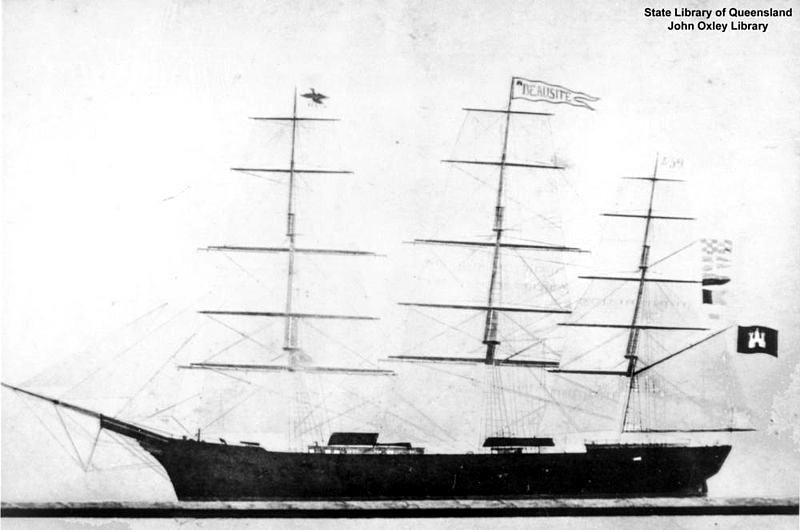
Beausite
dep. Hamburg 23 Oct 1864
arr. Moreton Bay 6 Feb 1865
Captain: Bruhn
Agent: J. C. Heussler & Co.
26 year old Friedrich on board the Beausite
1864 Friedrich Suchting
As the ship's records show, the 26 year old Friedrich Suchting, an agriculturalist (Landmann) from Ahrensbök in Holstein, boarded the Beausite to head off to Australia. The 932 ton Beausite departed Hamburg 23 October 1864 and arrived in Moreton Bay on 6 February 1865 under the charge of Captain Bruhm with C. Heussler and Co. as the agents.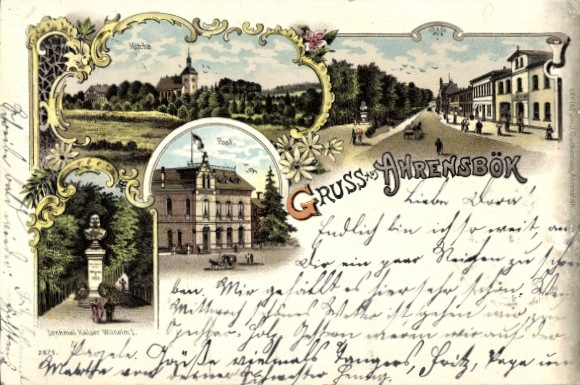
An old postcard of 'Ahrenssböök' (as pronounced in 'Holstation')
The trip from coast to coast was made in 104 days and except for some contrary winds off the Canary Islands had a smooth passage through the Atlantic and all the way to Tasmania. Cape Moreton was reached after another 13 days. Of the 300 immigrants on board, one half were single men and a very small proportion were single women. On the 8th February, the families and single females were conveyed to shore by a steamer, the Diamond. Due to the violence of the wind the steamer was required to return the next day to fetch the single men.
Those on board the Beausite shared their trip with a mixed cargo. This included 220 cases, 22 casks of wines, 60 cases geneva, 20 casks cognac, 3 cases pianos, 1 case books, 1 case cooper's utensils, 370 barrels cement, 533 packages, 5 cases of seltzer-water, 50 cases candles, 10 bales hay, 10 cases furniture, 10 rams and 40,000 fire bricks.
-
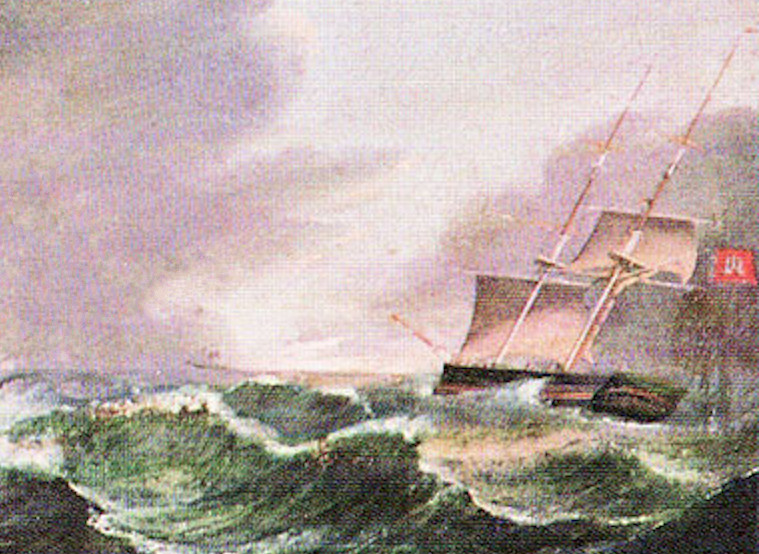
Helene
dep. Hamburg 8 Apr 1865
arr. Moreton Bay 2 Aug 1865
Captain: P. H. Hennings
Agent: J.C. Heussler & Co.
Wilhelmine with her family on board the Helene
1865 Wilhelmine Augusta Riek
The 366 ton Barque, Helene under Captain Hennings, departed Hamburg on the 8th of April 1865 and arrived in Moreton Bay on the 2nd of August 1865. Amongst the 150 passengers, were Friedrich Suchting's future wife, Wilhelmine Riek, together with her parents Friedrich and Dorothea and her younger brother Wilhelm. Dorothea's brother Christian Spann and his family had also gone along for the trip.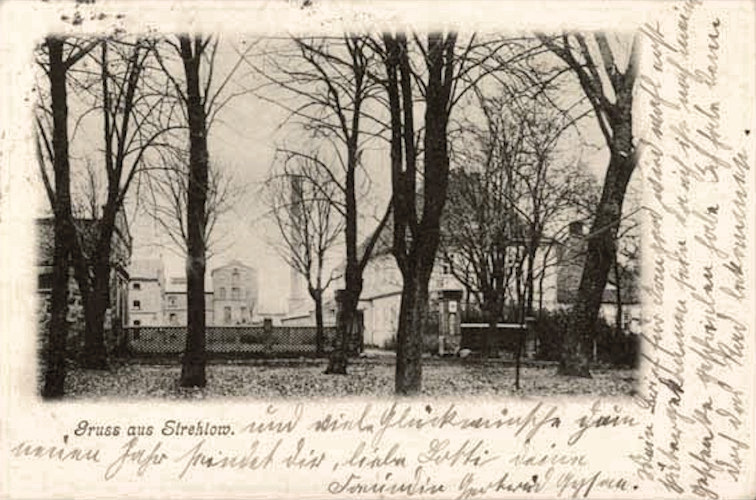
Old postcard from Potzlow
The Helene made a good run through mostly fine weather and on July 28, the 110th day, reached Cape Moreton, casting anchor on the 30th.
The passengers were transferred to shore on the evening of the 2nd. They were generally in good health during the trip with diseases being mostly pulmonary complaints, diarrhoea and others not of infectious character. In the northern seas five adults had died from diseases of the brain and two from lung disease. The only other death was that of a child from an infantile disorder. The major portion of the passengers were agriculturalists and travelled with assisted passage under the land-order regulations.
-

Sophie
dep. Hamburg 23 Apr 1865
arr. Moreton Bay 21 Aug 1865
Captain: Wendt
Agent: J. C. Heussler & Co.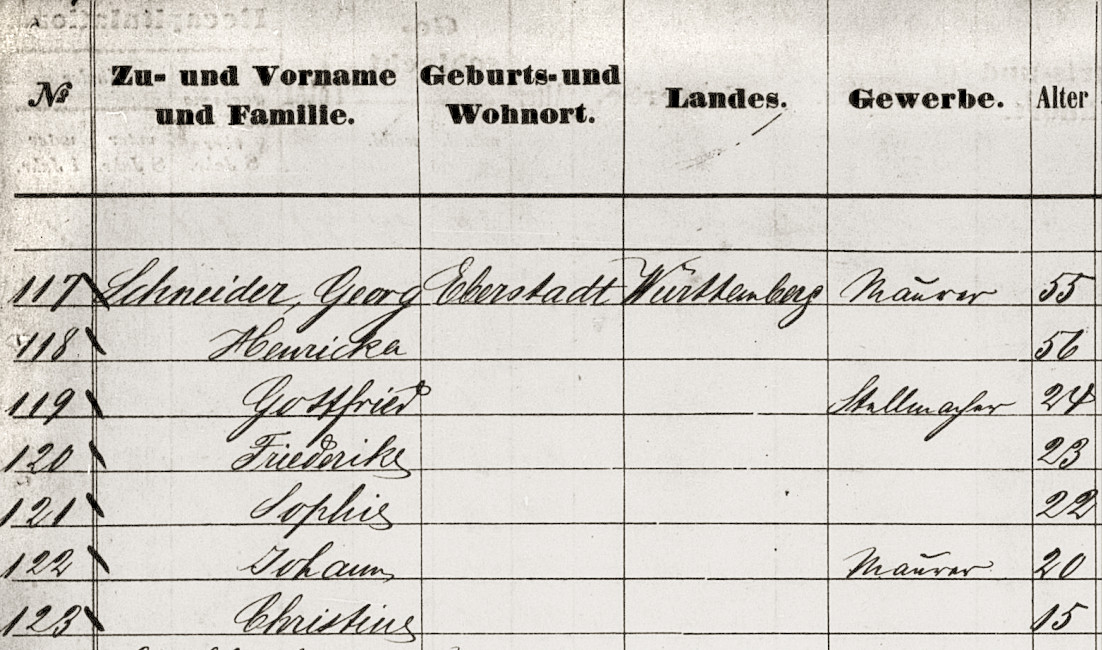
The Schneiders on board the Sophie
1865 Georg and Henricke Schneider
By the time Georg and Heinricke migrated with five of their children to the new Colony of Queensland, their eldest son Johann Heinrich had already been there with his wife and child since the year before. Apparently Johann Heinrich had sent back such encouraging reports about the prospect of a new life in the new land that the idea of going there too was irresistible.
Weinsberg (Doerr 1820)
So Georg, following in the footsteps of his son, packed up his family and made the 700 km trip to Hamburg from their home in Eberstadt in the district of Weinsberg. There they met up with their ship, the Sophie, which would take them to Australia. The Sophie departed from Hamburg under the command of Captain Wendt, on April 23, 1865 and arrived in Moreton Bay four months later, anchoring on August 17th. The 29 passengers who disembarked first needed a clean bill of health from the medical officer for which they had to wait until the 20th. On the 21st, the ship continued on with the rest of its 164 passengers and cargo to Maryborough.
-

Sophie
dep. Hamburg 23 Apr 1865
arr. Moreton Bay 21 Aug 1865
Captain: Wendt
Agent: J. C. Heussler & Co.
Friedrich Hinrichsen from Ahrensbök, Baker, 24, on board the Sophie
1865 Friedrich Hinrichsen
Johann Joachim Friedrich Hinrichsen, known as Friedrich, who was a baker from Ahrensbök, migrated to the new Colony of Queensland on the same ship as the family of Georg and Heinricke Schneider. In fact, exactly one year after their arrival, Friedrich married the second eldest daughter of the Schneiders, Friederike Sophie. The event occurred in the Baptist Church in North Ipswich.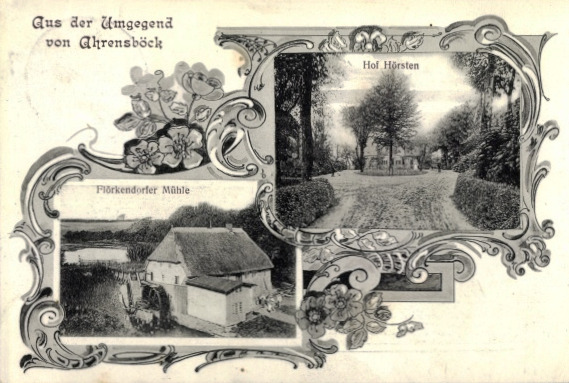
Postcard with scenes from around Ahrensböck
The Sophie departed Hamburg on April 23, 1865 under the command of Captain Wendt and arrived in Moreton Bay four months later, anchoring on August 17th. The 29 passengers who disembarked first needed a clean bill of health from the medical officer for which they had to wait until the 20th. On the 21st, the ship continued on with the rest of its 164 passengers and cargo to Maryborough.
-

Susanne Godeffroy
dep. Hamburg 6 May 1865
arr. Moreton Bay 6 Sep 1865
Captain: H. Müller
Agent: J. C. Heussler & Co.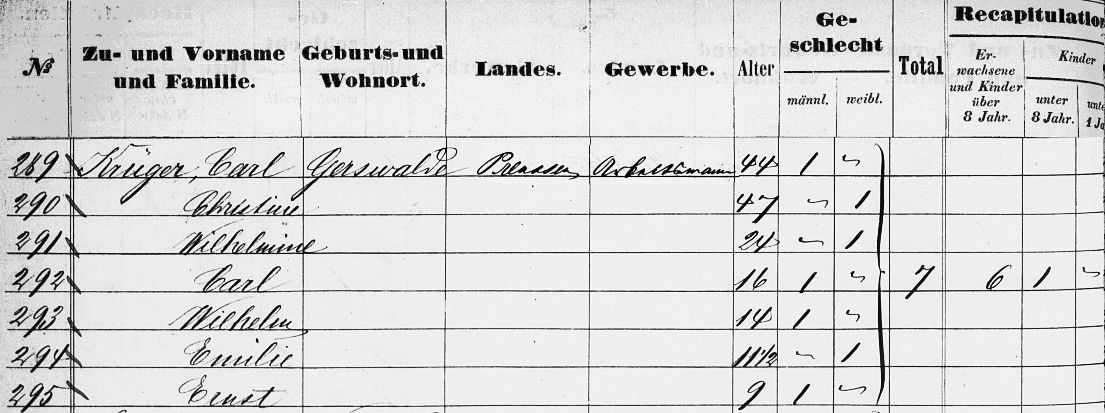
The Krügers on the Susanne Godeffroy in Hamburg and Brisbane
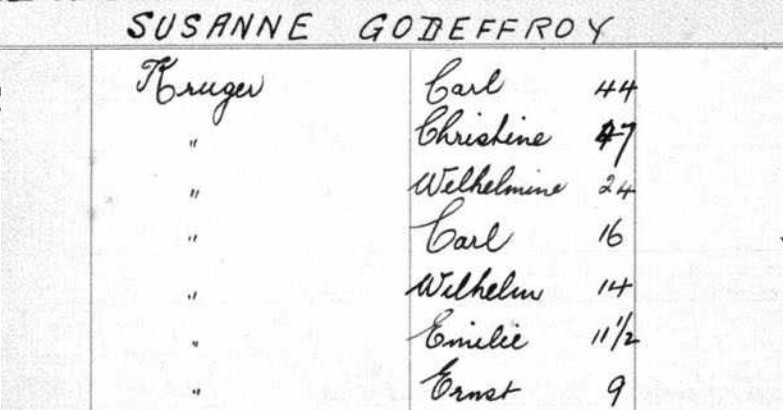
1865 Carl and Johanne Krüger
In 1926, when Pastor Carl Krüger was 76 years old, he wrote an autobiography documenting his life up to the age of 16 and how he and his six younger siblings migrated to Queensland with their parents, Carl and Johanne. Carl junior was born in a place called Seehausen on the shore of one of the Ucker Lakes but when he was three his parents relocated the family to Stegelitz.
Seehausen on a Prussian map
The voyage to the Great South Land began in Hamburg on May 6, 1865 but was not without peril. Having reached the Bay of Biscay they were caught in a tornado. The ship was set on its side and the passengers, having expected the worst, tried to clamber their way on deck only to find that they were locked in, which proved later to have prevented any of them from being washed overboard.
After a long period of nothing but the deafening noise of the storm, they heard a sound like an explosion. Slowly the vessel righted itself and the sailors began to sing. They were told the next morning that the storm had torn away five of the biggest and principal sails and thrown them into the sea and that was what saved them. Yet Carl held steadfast to his notion that a knife or some other cutting instrument had helped to cut them loose.
Finally at the end their rather adventurous trip, they sailed into Moreton Bay on September 6, 1865. In 1872, Carl married Johanna Lobegeiger, the sister of our 2x great-grandfather, Fred Lobegeiger. Carl's sister, Emily Krüger, married Johannes Lobegeier, the son of Wilhelmine nee Topp, our 2x great-grandmother, from her first marriage to Friedrich Lobegeier. Wilhelmine's second marriage was to our 2x great-grandfather, Johann Heinrich Schneider, the elder. Johann Heinrich, who was already a Baptist minister, was the one who baptised the young Carl Kruger and introduced him to a life of service to the church.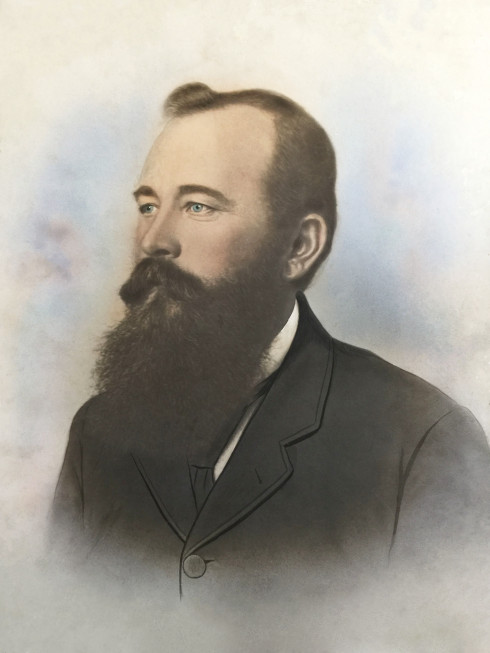
Carl Krueger Jr.
-
Wandrahm
Hamburg 15 Sep 1865 - Moreton Bay 12 Jan 1866
Captain: Henrick Bruhns
Agent: J. C. Heussler & Co.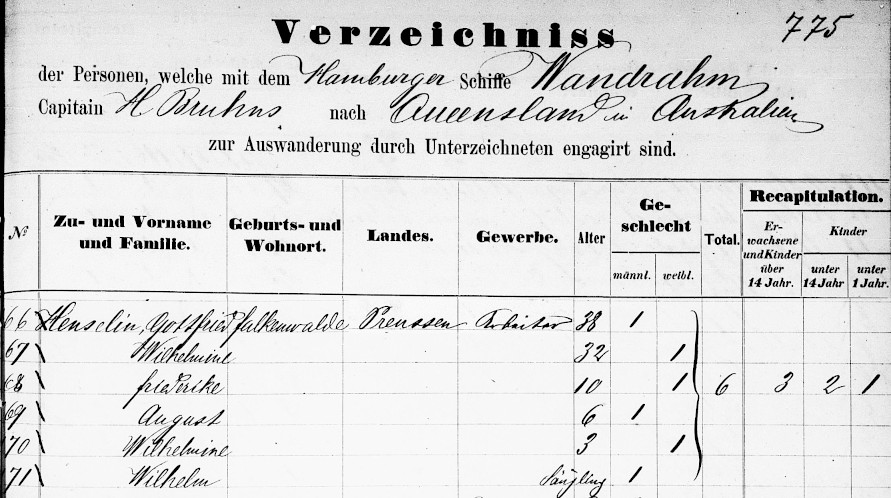
The Henselin family on board the Wandrahm
1865 Gottfried and Wilhelmine Henselin
Christian Friedrich Gottfried Henselin and his wife Maria Wilhelmine Dorothea Litzow along with the first four of their children, departed Hamburg on board the Wandrahm on the 15th of September, 1865 and sailed into Moreton Bay on January 13. One of those children, the eldest, was Auguste Wilhelmine Marie Ernestine Friederike Henselin who eventually married Johann Georg Schneider, the younger, in Ipswich on November 16, 1872.
Unlike most trips to Australia, the Wandrahm became such a nightmare that upon arrival in Queensland a court enquiry was set up. Passengers who were interviewed spoke of the horrendous conditions on board. Not only was there an enormous number of deaths, the sickness and disease had been running rampant ever since leaving Hamburg. Yet it didn't end there and continued during quarantine. Eventually all blame was placed upon the captain.
Scenes from an old postcard.
Greetings from Falkenwalde
Falkenwalde in the Uckermark of Preussen
The Henselin family came from a place called Falkenwalde, which not only boasts remnants from the stone age and Slavic settlement from the early middle ages but more recently, in 1357, it was already mentioned as Valkenworde in the historically important medieval record known as the Landbuch der Mark Brandenburg. From 1993 to 2001 it was an independent community within the Uckermark but nowadays is part of Uckerfelde.
-
Wandrahm
Hamburg 15 Sep 1865 - Moreton Bay 12 Jan 1866
Captain: Heinrich Bruhns
Agent: J. C. Heussler & Co.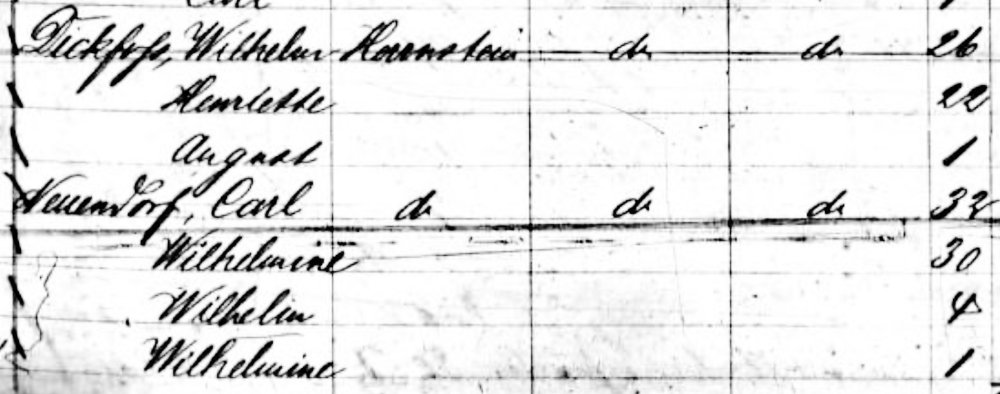
The Dickfoss and Neuendorf families on board the Wandrahm
1865 Wilhelm and Henriette Dickfoss
with Carl and Wilhelmine Neuendorf
Carl Friedrich Wilhelm Dickfoss and his wife Wilhelmine Caroline Henriette Hass and their 1 year old son, August, departed Hamburg on board the Wandrahm on the 15th of September, 1865 and sailed into Moreton Bay on January 13. Accompanying them were Wilhelm's sister, Johanna "Wilhelmine" Friederike Charlotte Dickfoss and her husband Johann "Carl" Martin Neuendorf, as well as their two children, 4 year old Wilhelm and the 1 year old Wilhelmine. They also had a new-born who died shortly before departure.
Yet, the trip was not a good one. Such an enormous number of deaths and cases of sickness occurred on board that a court inquiry was held to investigate the behaviour of the captain who was ultimately blamed for the horror inflicted upon the passengers. Tragically the little August Dickfoss, and both Wilhelm and Wilhelmine Neuendorf were counted amongst those victims who died on the ship. Worse still, Carl and Wilhelmine had a 7 day old baby who died a few days before the ship departed Hamburg,Herrenstein in the Uckermark of Preussen
This branch of the Dickfoss family came from a place called Herrenstein, which was founded in 1755 by Otto von Arnim as a Vorwerk belonging to Gerswalde. In 1821 it was officially called Herrenstein. By 1860 Herrenstein had 146 inhabitants, 11 dwellings, 26 outbuildings, 48 horses, 47 cows and 1600 sheep.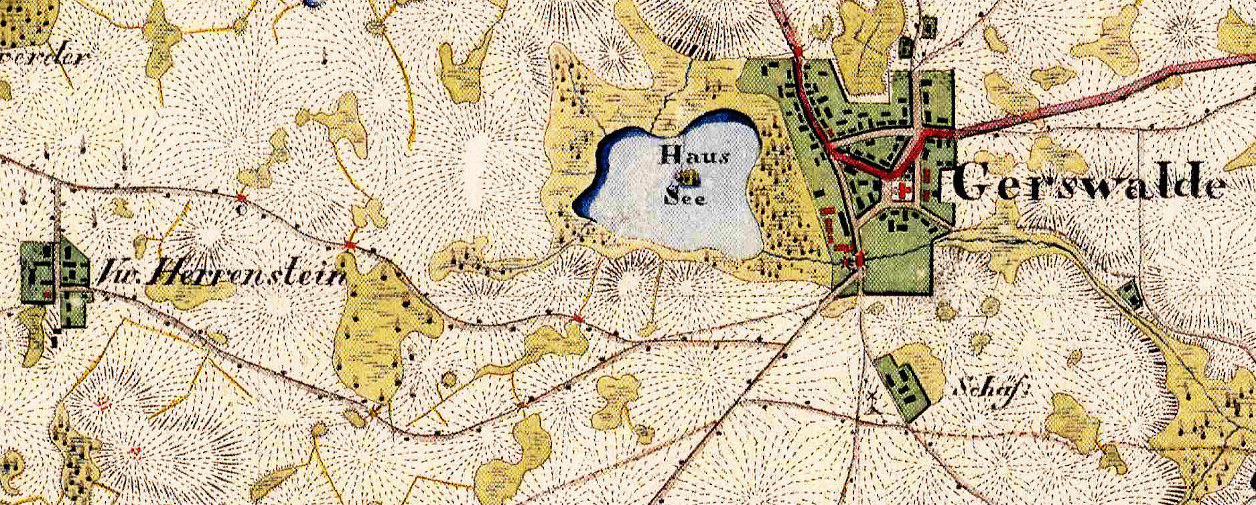
An old map showing Herrenstein 2.5 km west of Gerswalde
-

Cesar Godeffroy
dep. Hamburg 13 Oct 1865
arr. Moreton Bay 14 Feb 1866
Captain: Adalbert Decker
Agent: J. C. Heussler & Co.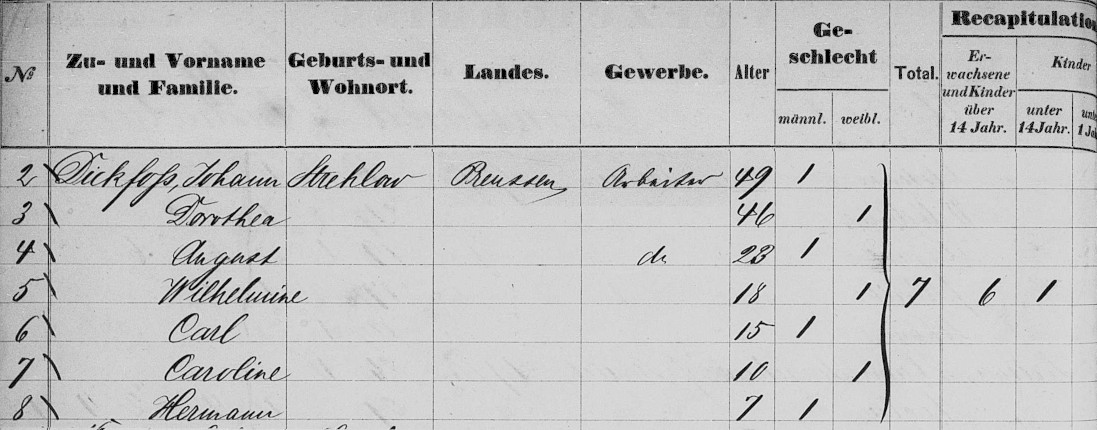
Johann and Dorothea with their children on board the Cesar Godeffroy
1865 Johann and Dorothea Dickfoss
Johann Christian Friedrich Dickfoss and his second wife Dorothea, nee Runge, left their home in Strehlow in the Uckermark of Prussia on the 13th of October, 1865 departing from Hamburg on board the Cesar Godeffroy, a ship built in Hamburg in 1865.
Strehlow is a village that lies a couple of kilometers north east of the Oberuckersee (Upper-Ucker-Lake) in the Uckermark. Their particular place of abode was most likely the Gutshof (Estate) belonging to the von Arnim family, originally known as a Ritterhof (Knight's Estate).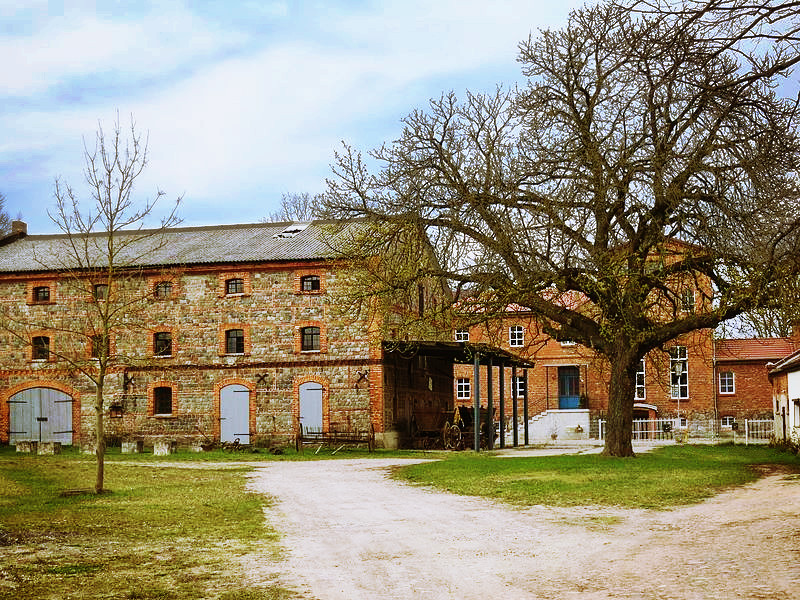
The Estate (Gutshof) at Strehlow
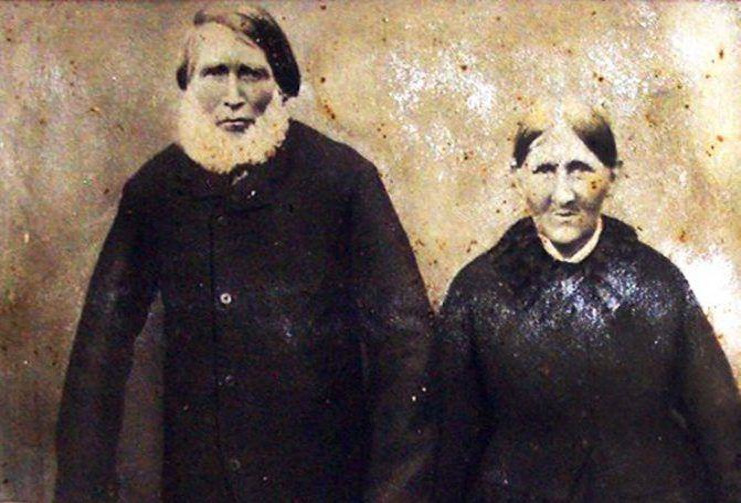
Johann and Dorothea Dickfoss
Nowadays Strehlow belongs to Potzlow in the district of the Oberuckersee which in turn is part of the Uckermark. The village was first written down in 1317 as Strele, and was later known as Stelow. The name is derived from a Slavic word meaning 'arrow' noting its location on the Mühlgraben which flows into the Ucker River.
The only child from Johann's first marriage to Johanne Friederike Riek, was named Johann Friedrich August Dickfoss, known later as simply August Dickfos, dropping one 's' on the end as was the fashion in Australia. He married Heinricke Sophie Schneider, the daughter of Johann Georg Schneider, in 1869. The eldest son of Johann and Dorothea, Johann Carl Dickfos, married Christine Schneider, another child of Johann Georg Schneider, in 1871. The second youngest child of Johann and Dorothea, Johanna Caroline Wilhelmine Dickfos (Caroline), married another child of Johann Georg Schneider, Gottfried Friedrich Schneider (Fred), also in 1871.
-

Herschel
dep. Hamburg 2 Dec 1871
arr. Moreton Bay 12 Mar 1872
Captain: E. A. Friederichs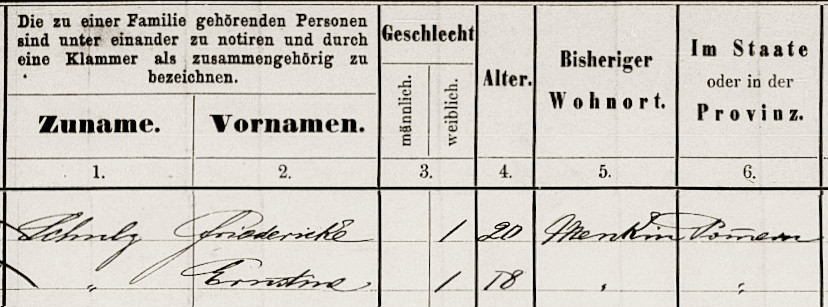
Ernestine and her sister Friederike on board the Herschel
1871 Ernestine Schulz
Ernestine Wilhelmine Schulz and her sisters Friederike, and Wilhelmine Christina hailed from Menkin in Pommerania, part of Prussia. The 18 year old Ernestine, 20 year old Friederike and 26 year old Wilhelmine sailed off from Hamburg to Australia on the Herschel on the 2nd of December 1871. Wilhelmine's husband August Friedrich Wilhelm Zimmermann and their baby daughter Ernestine accompanied the three sisters. After a passage of 96 days, having already sailed past Cape Moreton, the ship first anchored in Hervey's Bay and transferred the majority of the immigrants on board to Maryborough. The Maryborough Chronicle reported that "the passengers landed here are, in appearance, as fine a body of men and women as ever immigrated".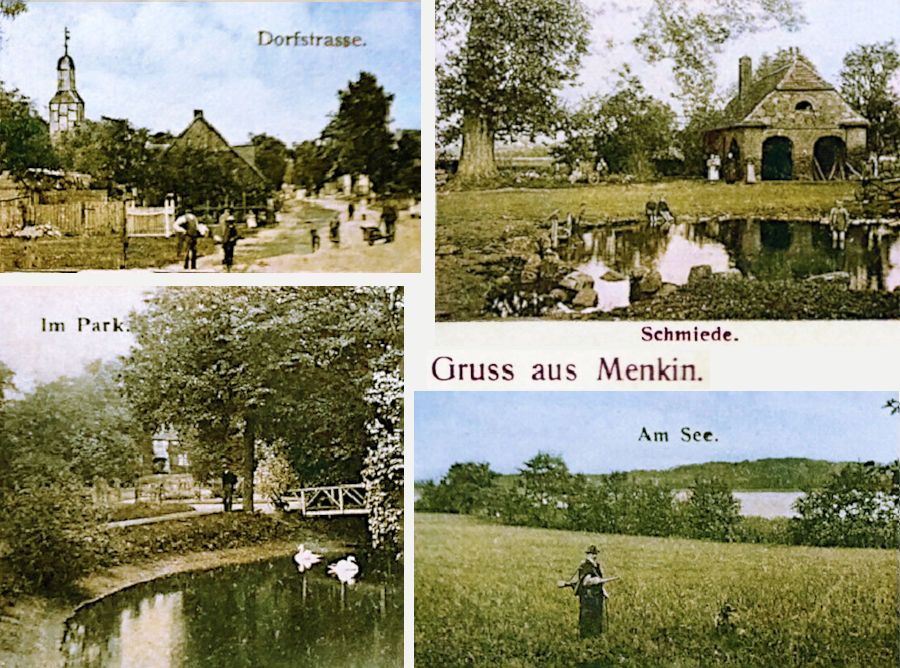
Old postcard of Menkin
Hurrah! The Brides Have Arrived
Upon approaching Maryborough, the steamer conveying the Herschel's passengers up the river created quite a bit of excitement. As it neared the crowds of awaiting relatives, friends, and migrant German men looking for wives, "the well known strains of 'Rhine Watch' resounding from several hundred lungs, fell on the ear. Thronging the deck in their quaint foreign-looking costumes, they sung as people only sing who have drunk month-long draughts of sea air, and whose hearts are light with the prospect of release from month-long confinement in a floating prison" (Maryborough Chronicle Tue 12 March 1872). The ship then proceeded further back down the coast with those passengers destined for Brisbane. This is where Ernestine and Friederike first set foot on Australian soil.
A New Life in a New Land
A few weeks after arriving, at the beginning of June, Ernestine's sister Friederike married Francis Victor Pfeffer who was a close friend and next door neighbour to Henry Schneider, our 2x great-grandfather. In October that same year, Ernestine who had just turned 19 a few months earlier, married a widower by the name of Johann Friedrich Wilhelm Pieper. Johann, the year before, had just lost his first wife Louise with whom he had migrated to Australia nine years earlier. So Ernestine not only gained a husband but also his seven children. She added five more to that number over the next ten or so years. One of those children, named Rudolph Pieper, was our great-grandfather.
